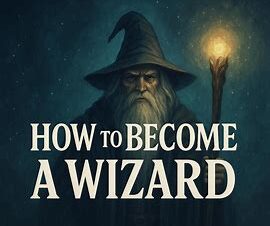“The Tools of the Wizard: Journals, Symbols, and Sacred Objects”
🎯 Learning Objectives
By the end of this section, you should be able to:
- Explain why tools are important in wizardry as symbols and anchors of intent.
- Create and begin using a personal wizard’s journal.
- Understand the role of symbols in shaping thought, memory, and practice.
- Identify common sacred objects used in wizardry and their meanings.
- Begin building your own basic toolkit as a student-wizard.
📜 Lecture Script
1. The Purpose of Tools in Wizardry
Tools are not magic in themselves—they are mirrors of the mind. A staff will not shoot lightning, and a robe will not give you wisdom. But a tool serves as a focus: it helps you shape intention, concentrate your thoughts, and embody a tradition.
Tools also mark transition. When you open your journal or light a candle, you step from the ordinary world into the wizard’s mindset. This is why tools are important—they remind you of your role as a seeker of wisdom.
2. The Wizard’s Journal
Your first and most essential tool is your journal.
- Think of it as your grimoire-in-training.
- It records your thoughts, lessons, experiments, symbols, and reflections.
- It is private but also part of your lineage—you may one day pass it on.
How to begin your journal:
- Choose a notebook that feels special to you. Leather-bound, handmade, or even a sturdy spiral-bound book.
- Dedicate the first page with a statement of intent, e.g., “This is the record of my journey as a wizard. May wisdom guide my words.”
- Record daily entries: observations of nature, dreams, symbols, reflections on lessons.
- Leave space for sketches, sigils, and diagrams.
A wizard without a journal is like a sailor without a compass.
3. The Power of Symbols
Symbols are the language of wizardry. They speak to the unconscious, carry meaning across generations, and compress deep truths into simple marks.
Examples of powerful symbols:
- The Pentacle – Balance of the five elements: earth, air, fire, water, and spirit.
- The Ouroboros – The serpent eating its tail, symbolizing cycles and eternity.
- The Eye – Awareness, perception, vigilance.
- Runes – Ancient Norse alphabet, used as both writing and mystical symbols.
Why symbols matter:
- They shape thought.
- They activate memory.
- They connect you to collective tradition.
Exercise: Draw three symbols that resonate with you in your journal. Write what each means to you.
4. Sacred Objects of the Wizard
Beyond the journal, wizards often use sacred objects. These are not “props”—they are anchors for focus and intention.
Common tools include:
- Staff or Wand – Focus of will and direction of energy.
- Chalice or Bowl – Vessel of water, reflection, emotion.
- Candle or Flame – Light, transformation, inspiration.
- Stone or Crystal – Memory, grounding, clarity.
- Robe or Cloak – Ritual garment, marking transition into wizardly space.
Each object has meaning, but what matters most is your relationship with it. A simple stone you picked up on a walk may carry more power for you than a store-bought crystal.
5. Indigo Wizard’s Tools
For Indigo Wizards, the most important tools are those that deepen self-reflection and metaphysical awareness:
- Dream Journal – Recording symbols from the unconscious.
- Mirror or Black Bowl – Used in meditation or scrying.
- Sigils – Personal symbols you create to embody intent.
- Meditation Beads – A tactile aid for focus and rhythm.
These tools train the Indigo mind to see patterns, symbols, and layers of meaning.
6. Building Your Toolkit Slowly
Do not rush to buy everything at once. Wizardry is not about consumerism. Begin with your journal, a candle, and a natural object that speaks to you. Over time, add what feels meaningful.
What matters is not the tool’s price, but your relationship with it. A staff carved by your own hand will carry far more power than one purchased.
7. Reflection Exercise
Take your journal and answer:
- What tools already exist in your life that could serve wizardry? (A pen, a notebook, a stone, a cup).
- Which tool do you feel most drawn to begin working with?
- How will you dedicate it as a wizard’s tool?
(continued in Part 4: The Wizard’s Code — Ethics and Responsibility)
📚 References
- Zell-Ravenheart, Oberon. Grimoire for the Apprentice Wizard. New Page Books, 2004.
- Buckland, Raymond. Signs, Symbols & Omens. Llewellyn Publications, 2003.
- Cunningham, Scott. Wicca: A Guide for the Solitary Practitioner. Llewellyn Publications, 1988.
- Grey School of Wizardry. www.greyschool.net
